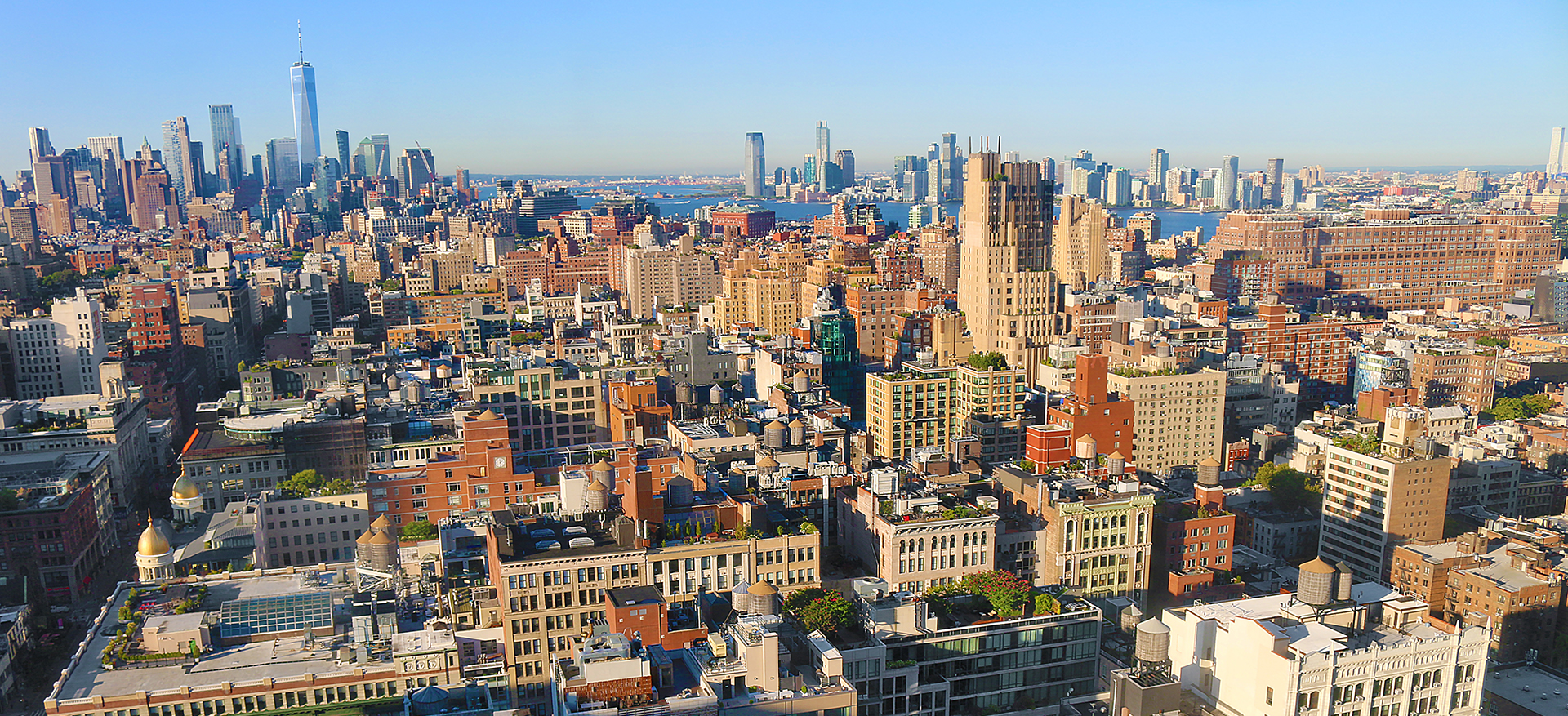Instead of large water towers — such as the Peachoid water tower in Gaffney, South Carolina — up to as many as 15,000 smaller water tanks can be seen atop buildings in the city of New York; and these seemingly quaint wooden rooftop water towers in New York have become legendary over the centuries of commerce and industrial growth of the largest city in the United States.
Why Wooden Rooftop Water Towers in New York?

Each of these rather unique structures can hold as much as 10,000 gallons of potable water — and filling them only takes a few hours at the most. Look closely, though, to note that they are little more than oversized wooden barrels with “rooftops” of their own.
Strangely enough, only three companies — all owned and operated by families for greater than a century — have been instrumental in building and maintaining the iconic water towers seen throughout the city of New York:
- Rosenwach Tank Company, which was established in 1866 by William Dalton, who originally manufactured wooden barrels
- Isseks Brothers, which was established in 1890
- American Pipe and Tank Lining Company, Incorporated, which has been building and maintaining water tanks in New York for greater than four generations
Even though their appearance seems old fashioned — like something out of the last century, which is true in many examples — wooden water tanks are still very much in use every day, from historic structures to the newest of luxury buildings.
History and Information Pertaining To Rooftop Water Towers

The water supply of the city of New York is fed via gravity from no fewer than three reservoirs from upstate — and the water only has enough momentum naturally to rise up to six stories. Water towers help to provide water at an adequate pressure to the floors above the sixth floor in both residential buildings and office buildings — much of the burden of distributing the water to sinks, toilets, showers, and bath tubs throughout the building shifts to the force of gravity itself — as well as in the unlikely event of having to help extinguish fires when necessary.
Water towers became a necessity as buildings became taller over the decades — primarily because industry in general continued to grow and evolve — and they still serve a very important purpose today of providing fresh clean water daily despite their nostalgic appearance.
“Settlers were originally drawn to the New York area for its rich waterways, however as industry grew in the 1800s, so did the grime and unsanitary conditions. In 1864, The Citizens Association of New York, started by a group of wealthy New Yorker’s, embarked on a mission to improve these conditions. Access to fresh, clean water was, of course, important to this mission”, according to this article from the official Internet web site of American Pipe and Tank. “In 1870, the Department of Public Works was tasked with improving drainage systems. Then, with the addition of indoor plumbing in the 1880s, water storage tanks began dotting the skyline.”
The few changes in the construction of water tanks over the years have amounted to little more than the introduction of power tools. Sometimes, the cedar from the discarded old tanks is sold to furniture manufacturers which specialize in reclaimed wood.
Wooden water towers last up to 35 years; can be built within 24 hours; and operate similarly to a simple toilet. When the water level recedes, a float valve automatically allows more water in, which refills the tank. An electric pump is used to pump water up into the tank — after which it is then disbursed within the building.
Moreover, wooden water tanks do not affect the taste or flavor of the water; and they are typically more environmentally friendly and more efficient than their steel counterparts. Although redwood was used at a time when it was reasonably priced, cedar is typically currently used. The wood plays an important role, as it acts as a natural insulator to prevent water from freezing in the winter. Although one wooden water tank may cost approximately $30,000.00, its steel alternative:
- Is more expensive at up to $120,000.00
- Requires up to two months to install instead of as few as 24 hours because more labor is needed
- Would require heavy layers of concrete to achieve the same efficiency and insulation
- Must be lined so that rust does not seep into the water
- Could also potentially become quite hot during the summer months

The water towers are constructed with untreated wood which is held in place by galvanized steel hoops that encircled them, so as not to pollute the water they hold — but because the wood is untreated, they very quickly take on a weathered look, in stark contrast to the glass and steel structures of the buildings on which they are situated. Aesthetically pleasing design choices are sometimes used to hide the wooden water towers on newer buildings, as while they may be considered iconic, wooden water towers are not always pleasing to the eye.
Water tanks are not manufactured from plastic because the material does not insulate well against heat and cold; and the use of fiberglass is prohibited by the official fire code of the city of New York.
Constructing and maintaining wooden water towers is a business which generates millions of dollars per year. One of the companies reported earning six million dollars one year just from wooden water towers.
Water is Not Always Clean Due to Poor Maintenance and Neglect of Wooden Water Tanks

For their storied history as part of the heritage of the city of New York, water towers must be properly maintained — otherwise, they present a potential health hazard.
“But inside these rustic-looking vessels, there are often thick layers of muddy sediment. Many have not been cleaned or inspected in years. And regulations governing water tanks are rarely enforced,” according to this investigative report which was written by Ray Rivera, Frank G. Runyeon, and Russ Buettner for The New York Times back on Monday, January 27, 2014. “Samplings taken by The New York Times from water towers at 12 buildings in Manhattan, Queens and Brooklyn found E. coli in five tanks, and coliform in those tanks and three more. Coliform by itself is not harmful, but does indicate that conditions are ripe for the growth of potentially dangerous microorganisms. The positive results all came from the bottoms of the tanks, below the pipe that feeds the buildings’ taps, though public health experts say the contamination is still a concern because the water circulates throughout the inside of the tanks.”
If E. coli is detected in the potable water system, an issuance of an order to boil water before it is used is required by federal law: “Boiled or bottled water should be used for drinking, making ice, brushing teeth, washing dishes, and food preparation until further notice. Boiling kills bacteria and other organisms in the water”, according to this document from the Environmental Protection Agency of the United States. “Inadequately treated or inadequately protected water may contain disease-causing organisms. These organisms can cause symptoms such as diarrhea, nausea, cramps and associated headaches. E. coli are bacteria whose presence indicates that the water may be contaminated with human or animal wastes. Human pathogens in these wastes can cause short-term effects, such as diarrhea, cramps, nausea, headaches, or other symptoms. They may pose a greater health risk for infants, young children, some of the elderly, and people with severely-compromised immune systems. These symptoms are not caused only by organisms in drinking water. If you experience any of these symptoms and they persist, you may want to seek medical advice.”
Contamination of potable water with fecal matter means that the wooden water tanks are subject to intrusion by animals such as birds and squirrels.
“But the vast system of safeguards protecting the water supply virtually ends at the curb”, according to the aforementioned article from The New York Times. “From that point on, it is up to building owners to ensure that their tanks are cleaned, inspected and tested for bacteria annually, as required by the city’s building and health codes.”
Final Boarding Call

More wooden water tanks are in the city of New York than in any other city in the United States. Those traditional wooden water tower has been commemorated not only by architects, residents, and owners of companies; but also by the manufacturers of wooden furniture and artists who are captivated by their appearance.
As far as the cleanliness of the water itself, I do not really care. I have never become sick as a result of drinking tap water in the city of New York, as it is the best water in the world to me — perhaps rivaled by water from Athabasca Glacier in the Rocky Mountains of Canada, which very likely has not been touched by humans over thousands of years; as well as select few other sources.
All photographs ©2022 by Brian Cohen.

